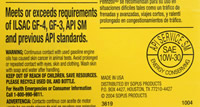Engine Oil Deep Dive - CAC's Comprehensive Look at Engine Oil and Flat-Tappet Camshaft Durability - Page 3 of 6
 |
 |
© 2009 by Hib Halverson
No use without permission, All Rights Reserved
![]() Discuss this article
Discuss this article
Backing Off the Catalyst Killer
Inevitably, the Federal government began to "stir the pot." By the late-'80s, the Federal Environmental Protection Agency (EPA) decided that phosphorous released by small quantities of oil burned by the engine gradually deactivates or "poisons" the reactant which enables a catalytic converter (some call them "catalysts" or just "cats") to convert certain exhaust gas components to less toxic substances. Once that happens, the cat becomes ineffective.
The EPA, deciding it was better for us to have expensive, long-life cats instead of more frequent replacements of "short-life" cats, offered car companies incentives for implementation of more durable catalysts. Politicians and EPA's mandarins figured the OE's would pressure the oil industry to scale back use of ZDP, thereby reducing phosphorous and preventing the premature demise of hundreds of millions of catalytic converters. This was a slow ramp-up, starting around the '80s at 50,000 miles. The current cat life requirement is 150,000 miles.
Sure enough, car companies, which, by the mid-'90s expected to be using either roller lifters in OHV engines or less highly-loaded, direct-acting flat tappets in OHC engines, convinced "big oil" to reduce phosphorous to extend cat life. Their leverage was the purchase of millions of gallons of oil a year to factory fill their engines and their recommending types of oils in owner's manuals.
In 1987, American car companies, along with Japanese manufacturers assembling cars in the U.S., formed the International Lubricant Standards and Approval Committee (ILSAC). One of ILSAC's goals was to enact standards which would gradually reduce phosphorous in engine oils carrying its and API's Service certifications.
In 2002, to improve the standards process, ILSAC, the oil industry and the additive makers formed the ILSAC/Oil committee. "Basically, it's worked out within that committee, from the OEM, the oil and the additive sides, what new oil specs will be," current ILSAC/Oil Chairman, Robert Olree told us in an interview. "My job, as chairman, is to keep all those cats...you've heard of herding cats...keep those guys in line and make sure the process keeps moving forward."
Herding cats, indeed! Imagine those meetings - all three groups with different goals, agendas and strategies. Heck, we can't understand why Mr. Olree wants the job at all.
ILSAC GF-1 ("GF" meaning "gasoline fueled") became effective in 1992. API followed with an "SH" version of its "Service" grades which, up until recently, were more familiar to consumers. GF-1 was the first oil standard with a phosphorous ceiling:1200 parts-per-million (PPM). API Service SF and prior, didn't regulate phosphorous.
This first "maxphos" number was irrelevant because, other than racing, diesel and other special purpose engine oils, which were not certified, anyway; most oil bought by Vette owners had way less than 1200 PPM phosphorous. Nevertheless, the seemingly pointless spec. was purposeful. "The first time we limited phosphorous, it was 0.12%," Olree told us. "The oil industry doesn't like restrictions, so we put it in at .12 just to get the idea in place. It wasn't affecting anybody because no one was above that. Later, we started ratcheting the phos down."
While GF-1 allowed up to 1200 PPM phosphorous, few of the GF-1 5W30s or 10W30s Corvetters used back then had more than 1000 PPM. So-called "racing oils" held phos to 1100-1300 PPM. Most oils purchased by consumers for engines in street cars ranged 800-1000 with a majority around 800, a figure which nearly half a century of research and experience proved was adequate to lubricate the vast majority of stock engines with flat tappet or finger follower valve trains and even some with mild, aftermarket, high-performance cams. Oils with viscosity higher than 10W30 were exempt from the phos limit.
In 1996, GF-2 was issued, and, in 2002, ILSAC/Oil released GF-3. API Service SJ is comparable to GF-2 and SL corresponds to GF-3. All of these mandated 1000 PPM max phos but, by then, most engine oils with viscosities 10W30 or less were about 800 with perhaps a few, during the GF-3 period, getting down between 600 and 800 PPM. Viscosities higher than 10W30 continued exempt from the phosphorous limit.
Where decreasing ZDP content first caused trouble was with engines having aftermarket, flat tappet camshafts with aggressive profiles, racing valve springs or high ratio rockers - parts which raise load at the lifter/lobe interface to over 200,000 psi. Such valvetrains required break-in procedures incorporating special additives, such as Comp Cams' "Cam Break-In" or Red Line's "Engine Oil Break-In Additive," both of which have additional ZDP, along with other components, such as molybdenum disulfide. Once break-in was complete, these engines needed an oil with 1000-1200 PPM phosphorous. Not all users of these cams were aware of this need and some who were aware, disregarded it.
With GF-1 through GF-3 and SJ to SL, phosphorous regulation was a maximum limit, not a minimum requirement. As long as oil companies didn't exceed that, they could put any percentage of ZDP in the oil necessary for it to pass the battery of tests required for certification.
GF-4 came in 2005 and was matched by API Service SM. GF-4 required oils with viscosities of 10W30 or lower to hold phos. above 600 PPM but below 800 PPM. This was the first specification which drove any significant change in oil blends, because previously, most had been at 800-1000 PPM, at or below any prior phosphorous ceiling but now, phos was held in a range. Viscosities higher than 10W30 continued to exempt from phos. limits.
GF-5, due for introduction for the 2011 model year is not yet finalized, but IL-SAC/Oil Chairman Olree, told the Corvette Action Center that he believes GF-5 will have the same phosphorous specification as GF-4.
 |
 |

